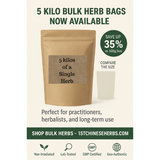

Plum Flower Powders
Andrographis Herb Powder - Chuan Xin Lian Bulk Bag
Andrographis Powder 5 Kilogram Bulk Bag (1 single bag) Why Is Andrographis Revered in Traditional Chinese Medicine?
For centuries, Da Huang (大黄) has stood as a pillar of Traditional Chinese Medicine—renowned for its ability to purge digestive accumulations, clear internal heat, eliminate toxins, and invigorate stagnant blood. Whether you're seeking natural relief from stubborn constipation, reducing inflammation and fever, cleansing skin from within, or promoting healthy blood flow, this potent root offers a powerful, natural solution rooted in ancient wisdom and backed by modern understanding. Let Da Huang restore balance where your body needs it most.
| Health Condition | How Da Huang Helps | Why It Works |
|---|---|---|
| Constipation | Promotes strong bowel movements and relieves chronic or severe constipation | High levels of anthraquinones (emodin, rhein) stimulate intestinal peristalsis and purge accumulations |
| Abdominal Distension | Reduces bloating and relieves fullness in the abdomen | Clears food stagnation and regulates Qi flow through the Stomach and Large Intestine |
| Food Stagnation | Enhances digestion and reduces accumulation of undigested food | Bitter and cold nature helps break down stagnant food and harmonizes the middle burner |
| High Fever & Delirium | Clears internal heat and reduces fire toxin symptoms | Bitter cold properties purge fire from Yangming and reduce pathogenic heat accumulation |
| Amenorrhea (Blood Stasis) | Promotes healthy menstrual flow when blocked by blood stasis | Invigorates blood and removes stasis by stimulating circulation and breaking clotted blood |
| Abdominal Masses | Assists in dissolving masses caused by stagnant blood or Qi | Resolves stagnation and accumulations through purgative and blood-invigorating effects |
| Skin Eruptions | Clears toxins from the blood to reduce boils, acne, carbuncles | Eliminates heat and toxins via bowel clearance; reduces systemic inflammation through detoxification |
Raw Da Huang: Used for its strong purgative effects.
Wine-processed Da Huang: Enhances blood-invigorating properties.
Charred Da Huang: Utilized to stop bleeding.
Typical Dose: 3–15 grams, decocted.
Administration: Often added late in the decoction process to preserve its purgative properties.
Modern research supports several traditional uses of Da Huang:
Laxative Effect: Anthraquinones stimulate intestinal motility.
Anti-inflammatory: Reduces inflammation by inhibiting pro-inflammatory cytokines.
Hepatoprotective: Protects liver cells from damage.
Antimicrobial: Inhibits the growth of various bacteria and fungi

Common Names: Chinese Rhubarb, Rhubarb Rhizome, Turkish Rhubarb, Rhubarb Root, Amla Vetasa
Botanical Name: Rheum Palmatum
Chinese / Pin Yin Name: Da Huang
When to Use Rhubarb Root:
Rhubarb root is primarily used in herbal medicine for its powerful medicinal properties. It is commonly utilized to address various health issues such as digestive problems, high cholesterol, inflammation, and even weight loss. This versatile root can be used as a supplement or brewed into a tea for maximum benefits.
How to Use Rhubarb Root:
To extract the therapeutic benefits of rhubarb root, it can be consumed in various forms like capsules, powders, tinctures, or teas. For digestive issues, steeping rhubarb root in hot water to make a tea can be effective. It is crucial to follow recommended dosages and consult a healthcare professional before incorporating rhubarb root into your routine.
Da Huang Dosage: Consult your healthcare provider for your correct dose.
Da Huang Precautions: Do not use if nursing or pregnant. Weak Patients, do not use with a weak constitution or those who suffer with diarrhea. Gastrointestinal Discomfort: Including abdominal pain and diarrhea. Electrolyte Imbalance: Prolonged use may lead to potassium depletion.

Da Huang is a traditional Chinese medicinal herb to drain dampness, invigorate blood, dispel blood stasis, and reduce fire toxicity. Da Huang benefits the throat, supports skin health and promotes normal bowel function. It has astringent, purgative and antiseptic effects.
What Are the Properties of Rhubarb:
Color and Texture:
High-quality Da Huang has a reddish-brown to yellow-brown color with visible fibrous striations. The cut pieces should feel solid and dense, not hollow or brittle.
Smell:
It should have a distinct aromatic, earthy scent with a slightly bitter undertone. A stale or musty smell indicates age or improper storage.

Da Huang Properties: Bitter, Cold
Da Huang Channels / Meridians: Large Intestine, Liver, Spleen
Da Huang Naturally Occurring Components: chrysophanol, rheumemodin, sennoside, herterodianthrome, chrysophanein, catechin, rhatannin, 2-O-Cinnamoyl - l,6-di-O-galloyl-β -D-glucoside
Da Huang's therapeutic effects are primarily attributed to its rich content of anthraquinones and tannins. Memorial Sloan Kettering Cancer Center
Anthraquinones: Emodin, rhein, chrysophanol, aloe-emodin
These compounds exhibit strong laxative effects by stimulating intestinal peristalsis
Tannins: Catechin, gallic acid
Possess astringent properties that can help in reducing intestinal inflammation.
Apricot Kernel Patchouli Notoginseng Scutellaria Baicalensis Amber
References
http://alternativehealing.org/da_huang.htm
https://tcmwiki.com/wiki/da-huang
https://www.americandragon.com/Individualherbsupdate/DaHuang.html
https://herbpathy.com/Uses-and-Benefits-of-Da-Huang-Cid1320